Related Research Articles

The House of Orange-Nassau is the current reigning house of the Netherlands. A branch of the European House of Nassau, the house has played a central role in the politics and government of the Netherlands and elsewhere in Europe, particularly since William the Silent organised the Dutch Revolt against Spanish rule, which after the Eighty Years' War (1568–1648) led to an independent Dutch state. William III of Orange led the resistance of the Netherlands and Europe to Louis XIV of France, and orchestrated the Glorious Revolution in England that established parliamentary rule. Similarly, Queen Wilhelmina of the Netherlands was instrumental in the Dutch resistance during World War II.
The Grand Ducal Family of Luxembourg constitutes the House of Luxembourg-Nassau, headed by the sovereign Grand Duke, and in which the throne of the grand duchy is hereditary. It consists of heirs and descendants of the House of Nassau-Weilburg, whose sovereign territories passed cognatically from the House of Nassau to the House of Bourbon-Parma, itself a branch of the Spanish Royal House which is agnatically a cadet branch of the House of Capet that originated in France, itself a derivative dynasty from the Robertians and the founding house of the Capetian dynasty.
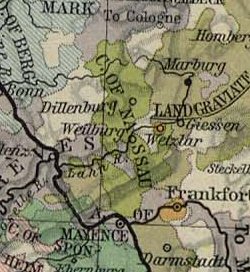
The County of Nassau was a German state within the Holy Roman Empire and later part of the German Confederation. Its ruling dynasty, the male line of which is now extinct, was the House of Nassau.

The grand duke of Luxembourg is the monarchical head of state of Luxembourg. Luxembourg has been a grand duchy since 15 March 1815, when it was created from territory of the former Duchy of Luxembourg. It was in personal union with the United Kingdom of the Netherlands until 1890 under the House of Orange-Nassau. Luxembourg is the world's only sovereign Grand Duchy and since 1815, there have been nine monarchs, including the incumbent, Henri.

Adolphe was Grand Duke of Luxembourg from 23 November 1890 to his death on 17 November 1905. The first grand duke from the House of Nassau-Weilburg, he succeeded King William III of the Netherlands, ending the personal union between the Netherlands and Luxembourg. Adolphe was Duke of Nassau from 20 August 1839 to 20 September 1866, when the Duchy was annexed to the Kingdom of Prussia.
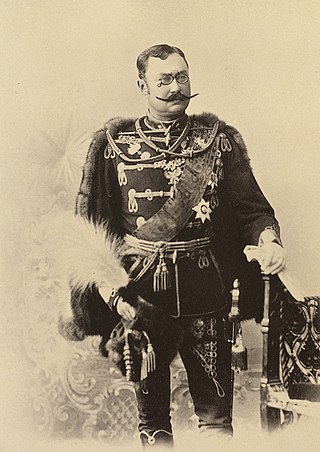
William IV reigned as the Grand Duke of Luxembourg from 17 November 1905 until his death. He succeeded his father, Adolphe. Like his father, William mostly stayed out of politics despite being vested with considerable power on paper by the Constitution.

Marie-Adélaïde, reigned as Grand Duchess of Luxembourg from 1912 until her abdication in 1919. She was the first Grand Duchess regnant of Luxembourg, its first female monarch since Duchess Maria Theresa and the first Luxembourgish monarch to be born within the territory since Count John the Blind (1296–1346).

Since 1983, the crown of the Netherlands passes according to absolute primogeniture. From 1814 until 1887, a monarch could only be succeeded by their closest female relative if there were no eligible male relatives. Male-preference cognatic primogeniture was adopted in 1887, though abolished when absolute primogeniture was introduced in 1983. Proximity of blood has been taken into consideration since 1922, when the constitution was changed to limit the line of succession to three degrees of kinship from the current monarch. In a situation where the monarch is succeeded by an eligible aunt or uncle, persons previously excluded could be reintroduced into the line of succession.
The Nassau Family Pact was a mutual pact of inheritance and succession made in 1783 by princes of the House of Nassau. It confirmed that Salic Law was to operate in favor of all the agnatic lines of the family, specifically the two senior surviving lines which had originated in the Middle Ages, the Walramian and the Ottonian. The pact chiefly provided that in case of one of these lines becoming extinct, the other would succeed in its hereditary Nassau lands.
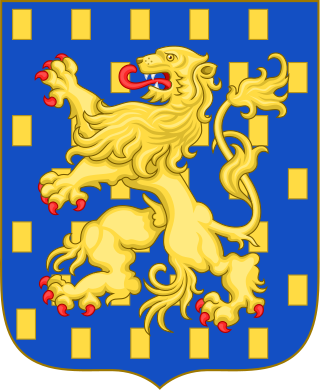
The House of Nassau is a diversified aristocratic dynasty in Europe. It is named after the lordship associated with Nassau Castle, located in present-day Nassau, Rhineland-Palatinate, Germany. With the fall of the Hohenstaufen in the first half of the 13th century royal power within Franconia evaporated and the former stem duchy fragmented into separate independent states. Nassau emerged as one of those independent states as part of the Holy Roman Empire. The lords of Nassau were originally titled "Count of Nassau", subject only to the Emperor, and then elevated to the princely class as "Princely Counts". Early on they divided into two main branches: the elder (Walramian) branch, that gave rise to the German king Adolf, and the younger (Ottonian) branch, that gave rise to the Princes of Orange and the monarchs of the Netherlands.
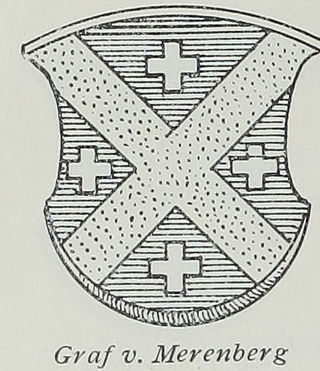
Count of Merenberg is a hereditary title of nobility that was bestowed in 1868 by the reigning Prince of Waldeck and Pyrmont, George Victor, upon the morganatic wife and male-line descendants of Prince Nikolaus Wilhelm of Nassau (1832–1905), who married Natalia Alexandrovna Pushkina (1836–1913), former wife of Russian general Mikhail Leontievich von Dubelt.

The Treaty of London, often called the Second Treaty of London after the 1839 Treaty, granted Luxembourg full independence and neutrality. It was signed on 11 May 1867 in the aftermath of the Austro-Prussian War and the Luxembourg Crisis. It had wide-reaching consequences for Luxembourg and for relations among Europe's great powers.
Since 2011, the crown of Luxembourg descends according to absolute primogeniture among Grand Duke Henri's descendants and according to agnatic primogeniture among other dynasts.
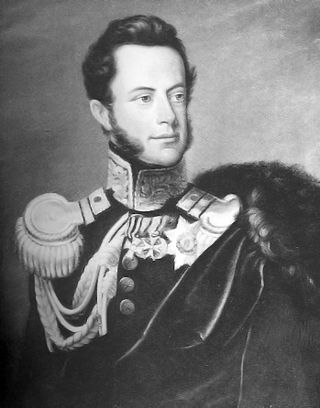
Wilhelm was joint sovereign Duke of Nassau, along with his father's cousin Frederick Augustus, reigning from 1816 until 1839. He was also sovereign Prince of Nassau-Weilburg from 1816 until its incorporation into the duchy of Nassau.

The County of Saarbrücken was an Imperial State in the Upper Lorraine region, with its capital at Saarbrücken. From 1381 it belonged to the Walram branch of the Rhenish House of Nassau.

Princess Adelheid-Marie of Anhalt-Dessau was a Princess of Anhalt-Dessau and member of the House of Ascania. As the wife of Adolphe of Nassau, she was Duchess of Nassau from 1851 until 1866 and Grand Duchess of Luxembourg from 1890 until 1905.

Clotilde, Countess von Merenberg is a German psychiatrist and the last patrilineal descendant of the House of Nassau. She is a descendant of Emperor Alexander II of Russia and of the Russian poet Alexander Pushkin.
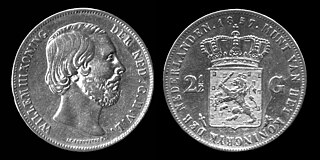
The style of the Dutch sovereign has changed many times since the establishment of the Kingdom of the Netherlands due to formations and dissolutions of personal unions, as well as due to marriages of female sovereigns and cognatic successions.

The Eyschen Ministry was in office in Luxembourg for 27 years, from 22 September 1888 to 12 October 1915. It was headed by Paul Eyschen, and ended with his death.
References
- ↑ "Constitution de Luxembourg" (PDF) (in French). Service central de législation. Archived from the original (PDF) on 2008-02-16. Retrieved 2007-07-01.
- ↑ New York Times . "Count Merenberg Protests: Would Not Have a Woman Reign in Luxembourg". 16 June 1907.
- ↑ (in French and German) "Mémorial A, 1907, No. 37" (PDF). Service central de législation. Retrieved 2008-01-14.
- ↑ "New Ducal succession rights for Grand Duchy". Luxemburger Wort. 21 June 2011. Archived from the original on 19 December 2012. Retrieved 11 July 2011.